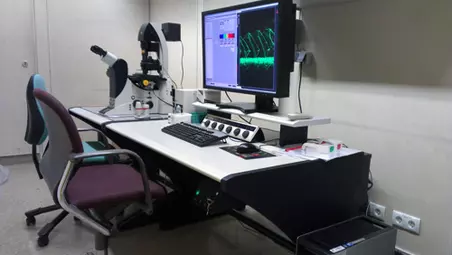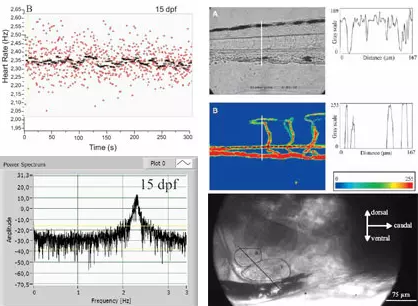Live Cell Imaging, Signal and Data Analysis
Live cell imaging and measurements on living cells are important tools in biological research. By using genetically encoded fluorescence proteins and sensors it is now possible to selectively label organelles and proteins in living cells. Our know-how in these research methods is reflected in research and teaching at the Institute of Zoology. Currently, we operate a Leica SP5 II LSM, a video measurement stand (Till Photonics, Polychrome V), a cell physiometer (Seahorse XFp) and a multimode platereader (Enspire, Perkin Elmer).

Reorientation of muscle fibers during asexual budding in a lifeact-transgenic Hydra polyp (see AG Hobmayer) IdU/CldU pulse-chase-pulse experiment showing stem cells in Macrostomum lignano (see AG Ladurner); GFP-labeled motoneurons in living zebrafish embryos (see AG Meyer, Inst. for Molecular Biology); acetylated tubulin in zebrafish cells (see AG Aanstad, Inst. for Molecular Biology); GFP-labeled mitochondria in zebrafish cells (see AG Pelster).
Leica SP5 II

The Leica TCS SP5 II is an inverted laser scanning microscope capable of capturing high resolution 3D images as well as fast quantitative processes. Our instrument is equipped with 405, 458, 476, 488, 496, 514, 561, 633 nm excitation wavelengths, a filter-free design and 4 detection channels (3 PMT, 1 HyD). The system has a motorized stage for "Mark&Find" or "Tile Scan" modes and delivers noise-free images with little bleaching.
To match, the setup has a Stage-Top Chamber from Okolab with atmospheric control of O2, CO2, humidity and temperature. Alternatively, we also have a CellASIC ONIX live cell imaging device from Merck for microfluidic perfusion of up to 4 parallel experimental sets.
A fee is charged for the use of the instrument to cover the smooth operation and future costs for laser exchange, service plan and consumables.
The fee is 15 €/hour or 40 €/4 hours, VAT included.
Registered users can reserve the device here.
Users should also subscribe to the mailing list lsmusers@lists.uibk.ac.at to receive updates and notices on the fly. Please send an e-mail with the subject "subscribe lsmusers firstname lastname" to sympa@lists.uibk.ac.at.

Another focus is on signal analysis techniques and data mining. Based on frequency analyses, they enable the description of oscillating physiological systems (e.g., heart function, muscle movement) and thus its dynamic properties. Data mining is the application of (statistical-mathematical) methods to a data set with the goal of pattern recognition.
Main applications of these techniques are the non-invasive measurement of cardiovascular and respiratory parameters, as well as the quantification of swimming movements in aquatic model organisms such as zebrafish, medaka and xenopus.
